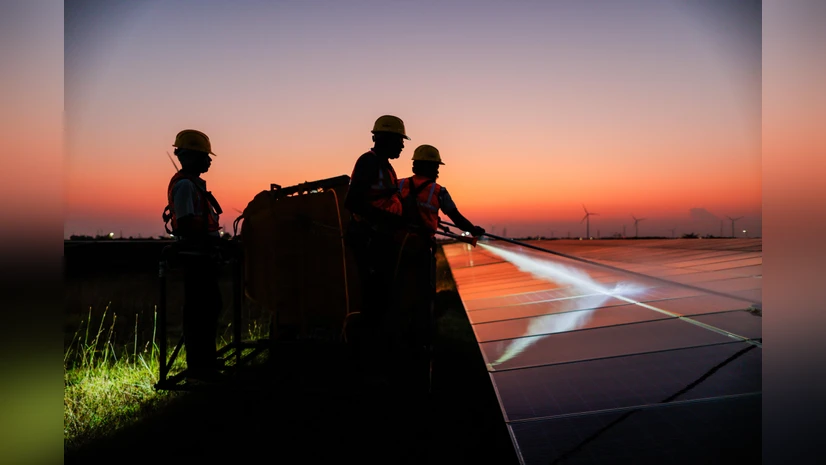India’s clean energy story has hit a new milestone. Between April and August 2025 (FY26), the country installed 20.1 gigawatts (GW) of renewable energy capacity—a record surge of 123% year-on-year (YoY). For context, the same period in the previous fiscal had seen just about 9 GW added.
Industry experts and credit ratings agency ICRA project that India could surpass 35 GW of total renewable capacity additions this fiscal year, driven by robust demand, favorable policies, and the expiration of key transmission incentives.
This achievement underscores India’s accelerating shift away from fossil fuels toward solar, wind, hydro, and emerging technologies like battery storage and green hydrogen.
🔑 Key Highlights
- 20.1 GW added in Apr–Aug FY26, up 123% from last year’s 9 GW.
- Total renewable additions in FY25 stood at 28.7 GW, compared to 18.5 GW in FY24.
- ICRA projects 35+ GW additions in FY26, backed by strong demand and pipeline.
- 142.8 GW renewable projects are in the pipeline, per the Central Electricity Authority (CEA).
- Challenges remain in land acquisition, transmission, and power purchase agreements (PPAs).
Why This Surge Happened Now
Several factors combined to push this record growth:
- Expiry of Transmission Waiver: The government’s waiver on inter-state transmission charges expired on 30 June 2025, pushing developers to accelerate project completions before the deadline.
- Affordable Solar Modules: International solar module prices, especially imported N-type modules, dropped to just 8–9 cents per watt. Although prices in India remain higher (15–17 cents per watt due to the ALMM order), developers still found them attractive given the current tariff environment.
- Policy Stability: India’s renewable sector enjoys strong backing from both the central government and state regulators. Long-term policies around tariff competitiveness, renewable purchase obligations (RPOs), and sustainability goals by corporates have kept investor sentiment high.
- Global Trade Dynamics: Interestingly, India’s solar exports rose 21% YoY in the first four months of FY26 as U.S. tariffs favored Indian manufacturers over some South Asian competitors.
The Role of Solar in India’s Energy Mix
Solar continues to be the backbone of India’s renewable expansion. Falling module prices, growing domestic manufacturing, and innovative financing models are making solar projects more bankable.
- Domestic Manufacturing Push: With the reinstatement of the Approved List of Modules and Manufacturers (ALMM) from April 2024, developers began stockpiling imported solar cells while scaling up local production capacity.
- Exports & Challenges: While exports boomed in early FY26, the recent 50% U.S. tariff on Indian solar imports poses a risk. This could dampen competitiveness and slow export growth going forward.
Wind, Hydro & Emerging Tech
Though solar dominates headlines, wind power has also contributed to capacity growth. Hybrid renewable projects that blend solar + wind + storage are gaining traction, particularly in states like Gujarat, Tamil Nadu, and Rajasthan.
Hydropower, too, is receiving renewed attention as part of India’s firm renewable capacity strategy, which aims to balance intermittent solar and wind output.
Emerging technologies such as green hydrogen, pumped hydro storage, and large-scale battery systems are also entering pilot and early commercialization stages, signaling the next frontier in India’s energy transition.
Tendering Pipeline: Strong but Slowing
The tendering pipeline remains robust:
- 47 GW auctioned in FY24
- 40.2 GW auctioned in FY25
- Only 3.4 GW auctioned so far in FY26 (H1)
The slowdown this year is largely due to delays in signing PPAs (Power Purchase Agreements) between bidding agencies and state distribution companies (discoms). These bottlenecks need urgent resolution to keep the project pipeline healthy.
Challenges That Could Slow the Momentum
Despite the record numbers, challenges persist:
- Land Acquisition: Securing large tracts of land for solar and wind farms often faces delays due to local resistance, bureaucratic hurdles, and competing land use.
- Transmission Infrastructure: Building and upgrading grid capacity to evacuate renewable power from remote locations remains a bottleneck.
- PPA Delays: State utilities, often under financial stress, have been slow in signing long-term agreements, impacting developers’ cash flows and timelines.
- Global Trade Risks: New tariffs, especially from the U.S., may reduce India’s export opportunities, potentially hurting domestic manufacturers.
The Road Ahead
Looking forward, India’s renewable energy expansion remains on a growth trajectory:
- A 142.8 GW project pipeline ensures momentum.
- Domestic solar manufacturing is scaling rapidly, reducing import dependency.
- Corporates are increasingly adopting renewable power purchase agreements as part of ESG commitments.
- Technological advancements in storage, smart grids, and hybrid projects will boost reliability.
If India indeed achieves 35+ GW renewable additions in FY26, it would be a global record for clean energy growth in a single year—a milestone that underscores the nation’s seriousness about meeting its net-zero 2070 goal.
Expert View
ICRA’s latest sector report calls the outlook “stable”, highlighting:
- Strong policy support.
- Cost competitiveness of renewables compared to thermal power.
- Sustainability initiatives by large industrial consumers.
However, the report also notes that execution challenges could delay capacity realization if not addressed quickly.
Conclusion
India’s renewable energy journey is gathering pace like never before. The record 20.1 GW capacity addition in just five months is not just a statistic—it’s a signal to the world that the country is committed to scaling clean energy at an unprecedented pace.
With supportive policies, growing demand, and a massive project pipeline, India is positioning itself as a global leader in renewable energy deployment. The challenges are real, but so is the momentum. If current trends hold, FY26 could go down as the year when India firmly cemented its place at the forefront of the clean energy revolution.
